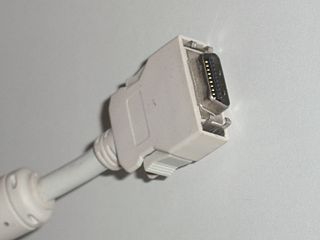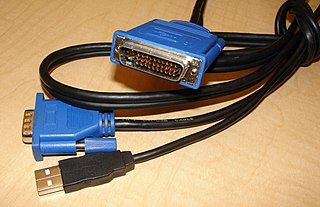 W
WThis is a list of physical RF and video connectors and related video signal standards.
 W
WThe Apple Display Connector (ADC) is a proprietary modification of the DVI connector that combines analog and digital video signals, USB, and power all in one cable. It was used in later versions of the Apple Studio Display, including the final 17" CRT model, and most versions of the widescreen Apple Cinema Display, after which Apple adopted standard DVI connectors on later models.
 W
WThe VESA Digital Flat Panel (DFP) interface standard specifies a video connector and signaling for flat-panel displays. It features 20 pins and uses the PanelLink protocol.
 W
WDigital Visual Interface (DVI) is a video display interface developed by the Digital Display Working Group (DDWG). The digital interface is used to connect a video source, such as a video display controller, to a display device, such as a computer monitor. It was developed with the intention of creating an industry standard for the transfer of digital video content.
 W
WDisplayPort (DP) is a digital display interface developed by a consortium of PC and chip manufacturers and standardized by the Video Electronics Standards Association (VESA). The interface is primarily used to connect a video source to a display device such as a computer monitor, and it can also carry audio, USB, and other forms of data.
 W
WDMS-59 was generally used for computer video cards. It provides two Digital Visual Interface (DVI) or Video Graphics Array (VGA) outputs in a single connector. A Y-style breakout cable is needed for the transition from the DMS-59 output to DVI (digital) or VGA (analogue), and different types of adapter cables exist. The connector is four pins high and 15 pins wide, with a single pin missing from the bottom row, in a D-shaped shell, with thumbscrews. As of December 2020, this adapter cable was listed as obsolete by its primary vendor Molex.
 W
WThe VESA Enhanced Video Connector is a VESA standard intended to reduce the number of cables around a computer by incorporating video, audio, FireWire and USB into a single cable system. The intention of the system was to make the monitor the central point of connection. Although the specific idea did not find favour with computer manufacturers, it was evolved into the somewhat more popular VESA Plug and Display standard.
 W
WHigh-Definition Multimedia Interface (HDMI) is a proprietary audio/video interface for transmitting uncompressed video data and compressed or uncompressed digital audio data from an HDMI-compliant source device, such as a display controller, to a compatible computer monitor, video projector, digital television, or digital audio device. HDMI is a digital replacement for analog video standards.
 W
WA low-force helix (LFH-60) is a 60-pin electrical connector with signals for two digital and analog connectors. Each of the pins is twisted approximately 45 degrees between the tip and the plastic frame which holds the pins in place. Hence "helix" in the name.
 W
WThe Micro-DVI port is a proprietary video output port found in the original MacBook Air. It is smaller than the Mini-DVI port used by its MacBook models.
 W
WThe Mini DisplayPort is a miniaturized and less common version of the DisplayPort audio-visual digital interface.
 W
WThe Mini-DVI connector is used on certain Apple computers as a digital alternative to the Mini-VGA connector. Its size is between the full-sized DVI and the tiny Micro-DVI. It is found on the 12-inch PowerBook G4, the Intel-based iMac, the MacBook Intel-based laptop, the Intel-based Xserve, the 2009 Mac mini, and some late model eMacs.
 W
WOpenLDI is a high-bandwidth digital-video interface standard for connecting graphics/video processors to flat panel LCD monitors. Even though the promoter’s group originally designed it for the desktop computer to monitor application, the majority of applications today are industrial display connections. For example, displays in medical imaging, machine vision, and construction equipment use the OpenLDI chipsets.
 W
WPDMI is an interconnection standard for portable media players. It has been developed by CEA as ANSI/CEA-2017-A standard Common Interconnection for Portable Media Players in February 2010. Chaired by David McLauchlan from Microsoft, the standard was developed with the input or support of over fifty consumer electronics companies worldwide.
 W
WVESA Plug and Display (P&D) is a video connector for digital monitors, such as flat panel displays and video projectors, ratified by VESA. It was introduced around the same time as DFP, marketed as a replacement of VESA Enhanced Video Connector (EVC) and an extension of DVI. Unlike DVI, it never achieved widespread implementation.
 W
WSerial digital interface (SDI) is a family of digital video interfaces first standardized by SMPTE in 1989. For example, ITU-R BT.656 and SMPTE 259M define digital video interfaces used for broadcast-grade video. A related standard, known as high-definition serial digital interface (HD-SDI), is standardized in SMPTE 292M; this provides a nominal data rate of 1.485 Gbit/s.
 W
WTransition-minimized differential signaling (TMDS), a technology for transmitting high-speed serial data, is used by the DVI and HDMI video interfaces, as well as by other digital communication interfaces.
 W
WA very-high-density cable interconnect (VHDCI) is a 68-pin connector that was introduced in the SPI-2 document of SCSI-3. The VHDCI connector is a very small connector that allows placement of four wide SCSI connectors on the back of a single PCI card slot. Physically, it looks like a miniature Centronics type connector. It uses the regular 68-contact pin assignment. The male connector (plug) is used on the cable and the female connector ("receptacle") on the device.